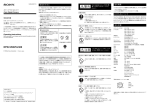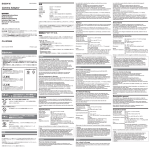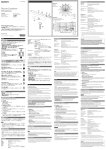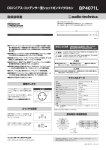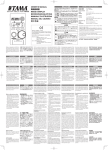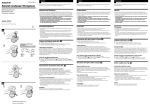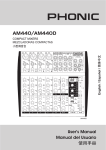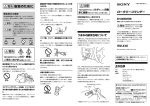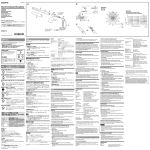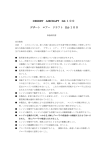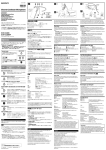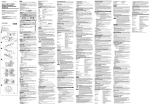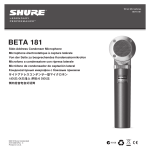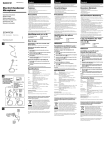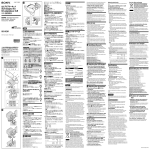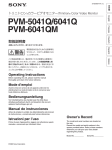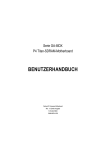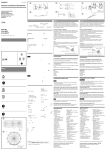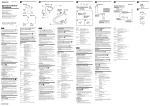Download Electret Condenser Microphone
Transcript
3-992-724-01(1) A B 標準指向特性図 Directivity Directivité Electret Condenser Microphone 取扱説明書 Operating Instructions Mode d’emploi Bedienungsanleitung Istruzioni per l’uso Manual de instrucciones マイクの出力端子へ/ To the microphone/ Au microphone 標準周波数特性 Frequency response characteristics Caractéristiques de réponse en fréquence お買い上げいただきありがとうございます。 この取扱説明書には、事故を防ぐための重要な注意事項と製品の取り扱いかたを示 しています。 この取扱説明書をよくお読みのうえ、製品を安全にお使いください。お読 みになったあとは、いつでも見られるところに必ず保管してください。 ビデオカメラの入力端子へ/ To the video camera/ A la caméra vidéo ECM-673 Réponse レスポンス/Response/ 電気製品は、安全のための注意事項を守らないと、けがをしたり周辺 の物品に損害を与えることがあります。 周波数/Frequency/Fréquence Sony Corporation ©2006 Printed in Japan * マイクロホンの各方向に風速2 m/secの気流を当てたとき、マイクロホンに発生す る雑音出力の平均値を等価入力音圧に換算した値。 (0 dB=2×10−5 Pa) 日本語 安全のために ソニー製品は安全に充分に配慮して設計されています。 しかし、製品は、 まちがった 使いかたをすると、けがにつながることがあり、危険です。 事故を防ぐために次のことを必ずお守りください。 •「安全のために」の注意事項を守る。 • 長期間安全にお使いいただくために、定期点検をすることをおすすめします。点 検の内容や費用については、お買い上げ店にご相談ください。 • 故障したら使わずに、お買い上げ店にご相談ください。 警告表示の意味 注意を促す記号 解してから本文をお読みください。 行為を禁止する記号 ・ 周囲雑音を拾いにくい鋭指向性 鋭い指向性を持ち、卓上での集音をはじめ、屋外での狭角度集音やビデオカメ ラへの搭載など、中距離集音に適しています。 ・ 小型・軽量 全長200mm、重さ135gで、使いやすく持ち運びに便利です。 ・ 外部給電方式専用マイク 駆動電源電圧DC 40V∼52Vの外部電源方式に対応しています。 各部の名称と使いかた (図A) 行為を指示する記号 下記の注意を守らないと、 けがをしたり周辺の 物品に損害を与えることがあります。 集音以外の目的に使用しない 集音以外の目的でご使用になりますと、思わぬ事故、 火災やけがの原因となることがあります。 使用時は周囲の状況に注意をはらう 周囲の状況を把握しないままご使用になりますと、事 故やけがなどの原因となります。 雨のあたる場所や、油煙、湯気、湿気、ほこりの多い場所に 設置しない (文の番号と図の番号を照らし合わせてご覧ください。) 1 マイク本体 2 LOW CUTスイッチ 風雑音等を効果的にカットします。 M( ): 標準特性 V( ): LOW CUT特性 3 出力端子(XLR-3-12Cタイプ) マイクで集音した音声が出力されます。 また、外部電源使用時には、電源が外 部から供給されます。 4 マイクスペーサー マイクホルダー (カメラに搭載または別売り) を介して、マイクをビデオカメラ に取り付けるときに使います。 5 ウインドスクリーン マイク本体1にかぶせて使うと、風や息がマイクに直接当たるときに生じる雑 音を低減します。 6 マイクホルダー マイクロホンスタンド(別売り) にマイクを取り付けるとき使います。角度調整 部のネジがゆるんだときには、 コイン等で締め付けてください。 7 接続コード マイクの出力端子3とビデオカメラの入力端子(XLRタイプ) を接続します (ケーブル長:500mm) 。 なることがあります。 運搬時には、接続ケーブルを取り外す 本機を運搬する際には、接続ケーブルを必ず取り外し 分解や改造をしない 分解や改造をすると、火災やけがの原因となることが あります。 内部に水や異物を入れない 水や異物が入ると火災や感電の原因となることがあり ます。万一、水や異物が入った場合は、すぐに電源を 切り、接続コードを抜いて、お買い上げ店またはソ ぐらいついた台の上や傾いたところに設置すると、製 品が落下してけがをすることがあります。 この製品には保証書が添付されていますので、お買い上げの際お受け取りくださ い。所定事項の記入および記載内容をお確かめのうえ、大切に保存してください。 保証期間は、お買い上げ日より1年間です。 アフターサービス ・ 調子が悪いときは この説明書をもう一度ご覧になってお調べください。 ・ それでも具合の悪いときは お買い上げ店、 または添付の「ソニーご相談窓口のご案内」 にあるお近くのソ ニーサービス窓口にご相談ください。 ・ 保証期間中の修理は 保証書の記載内容に基づいて修理させて頂きます。詳しくは保証書をご覧くださ い。 ・ 保証期間経過後の修理は 修理によって機能が維持できる場合は、ご要望により有料修理させて頂きます。 English Before using the microphone, please read this manual thoroughly. This manual should be retained for future reference. For the customers in Europe This product with the CE marking complies with the EMC Directive (89/ 336/EEC) issued by the Commission of the European Community. Compliance with this directive implies conformity to the following European standards: • EN55103-1: Electromagnetic Interference (Emission) • EN55103-2: Electromagnetic Susceptibility (Immunity) This product is intended for use in the following Electromagnetic Environment(s): E1 (residential), E2 (commercial and light industrial), E3 (urban outdoors), and E4 (controlled EMC environment, ex. TV studio). • LOW CUT switch which cuts unnecessary low frequency The low cut filter reduces the noise occurring due to wind or vibration. このマイクは外部給電方式専用です。マイクの出力端子3と外部電源機器のAC パワーサプライ (ソニーAC-148Fなど)や、オーディオミキサー、 またはカムコー ダーのマイク端子を接続します。接続には、マイクロホンケーブルをご使用くださ い。 ご注意 • External power supply The microphone can be powered on an external power supply of 40 V to 52 V DC. ク入力端子があることをあらかじめご確認ください。 • このマイクには不平衡型ケーブルは使用できません。必ず平衡型ケーブルを使 用してください。 1 Microphone 2 LOW CUT switch 3 使用上のご注意 • マイクロホンは敏感です。落としたり、強いショックを与えたりしないようにしてく ださい。 • 高温多湿、特に気温が60℃以上のところで長時間使用・保存することは避けて 4 ください。 「ピー」 という音 (ハウリング) が発生することがあります。 これは、スピー • 使用中、 カーから出る音をマイクロホンが拾ってしまうために起こります。 これを防ぐに は、マイクロホンとスピーカーを向き合わないようにし、その距離をできるだけ 離してください。 主な仕様 形式 電源 消費電流 出力端子 外形寸法 質量 付属品 バックエレクトレットコンデンサー型 外部供給方式 DC 40∼52 V 2 mA以下 キャノン XLR-3-12C タイプ φ20×200 mm 約135g ウィンドスクリーン(1)、マイクホルダー(1)、マイクスペーサー(1)、接続 コード(1)、取扱説明書(1)、保証書(1) 以下の項目はJIS C-5502-1991 マイクロホン工業規格に準拠して試験したもの です。 周波数特性 40 Hz∼20,000 Hz 指向特性 鋭指向性 出力インピーダンス 220Ω±20% 平衡型 正面感度(偏度±3 dB)−36dB(0 dB=1 V/Pa、1 kHz) 雑音 信号対雑音比 77 dB SPL以上(IEC 179 A-weighted、1 kHz、1 Pa) 固有雑音 17 dB SPL以下(0 dB=2×10−5 Pa) * 風雑音 45 dB SPL以下(ウィンドスクリーン装着 時)/50 dB SPL以下(ウィンドスクリー ン未装着時) 外部磁界の誘導雑音 0 dB SPL/1×10−7 T(1 mG)以下 最大入力音圧レベル 124 dB SPL(マイクロホンの出力信号が1 kHzで1% の波形ひずみを生じる入力レベルの等価入力音圧換算 値、0 dB=2×10−5 Pa) ダイナミックレンジ 107 dB SPL以上 許容動作温度 0℃∼+50℃ 許容保存温度 −20℃∼+60℃ Performance Frequency response 40 Hz to 20,000 Hz Directivity Super cardioid Output impedance 220Ω ±20%, balanced Sensitivity (deviation ±3 dB) –36 dB (0 dB = 1 V/Pa at 1 kHz) Signal-to-noise ratio More than 77 dB SPL (IEC 179, A-weighted, 1 kHz, 1 Pa) Inherent noise Less than 17 dB SPL (0 dB = 2 × 10–5 Pa) Less than 45 dB SPL (with wind screen) Wind noise* Less than 50 dB SPL (without wind screen) Induction noise from external magnetic field Less than 0 dB SPL/1 × 10-7 T (1 mG) Maximum input sound pressure level 124 dB SPL (input level for 1% waveform distortion at 1 kHz, converted into equivalent input sound pressure level: 0 dB = 2 × 10–5 Pa) Dynamic range More than 107 dB SPL Operating temperature 0 °C to +50 °C (32 °F to 122 °F) Storage temperature –20 °C to +60 °C (–4 °F to 140 °F) * Wind noise is the value measured by applying a wind velocity of 2 m/ sec. (6.6 ft/s) to the microphone from all directions. The mean value is taken and converted to the equivalent sound pressure level. (0 dB = 2 × 10–5 Pa) Français Avant d’utiliser ce microphone, lisez attentivement ce mode d’emploi à conserver pour toute référence ultérieure. Pour les clients européens Ce produit portant la marque CE est conforme à la Directive sur la compatibilité électromagnétique (EMC) (89/336/CEE) émise par la Commission de la Communauté européenne. La conformité à cette directive implique la conformité aux normes européennes suivantes: • EN55103-1: Interférences électromagnétiques (émission) • EN55103-2: Sensibilité électromagnétique (immunité) Ce produit est prévu pour être utilisé dans les environnements électromagnétiques suivants: E1 (résidentiel), E2 (commercial et industrie légère), E3 (urbain extérieur) et E4 (environnement EMC contrôlé, ex. studio de télévision). Names and Functions of Parts (Fig. A) (The numbers refer to the corresponding numbers in the figure.) • このマイクをカムコーダーに接続する前に、カムコーダーに+48 V対応のマイ Back electret condenser microphone External power supply operation 40 V to 52 V DC Less than 2 mA Cannon XLR-3-12C type 20 dia. × 200 mm (13/16 dia. × 7 7/8 in.) Approx. 135 g (4.8 oz) Wind screen (1), microphone holder (1), microphone spacer (1), connecting cord (1), Operating Instructions (1), warranty booklet (1) Features • Compact and lightweight Owing to its small dimensions of 20 dia. × 200 mm and weight of 135 g, the microphone can be used and carried easily. 電源について General Type Power supply Current drain Output connector Dimensions Mass Supplied accessories Design and specifications are subject to change without notice. マイクホルダー (別売り)8を使ってビデオカメラに装着するときは、図のようにマ イクスペーサー4をかぶせ、マイク本体のUPマークが上側にくるようにマイクホ ルダーに取り付けると、正しい指向特性が得られます。 ニーのサービス窓口にご相談ください。 安定した場所に設置する 保証書 ビデオカメラへの取り付けかた (図B) てください。接続ケーブルに引っ掛かると、転倒や落 下の原因となることがあります。 保証書とアフターサービス • Super cardioid microphone with minimum sensitivity to ambient noise The microphone’s sharp directivity makes it suitable for middle distance recording such as at conference and lectures, for use on a video camera, and for recording outdoors within a narrow range. 上記のような場所やこの取扱説明書に記されている仕 様条件以外の環境に設置すると、火災や感電の原因と 仕様および外観は改良のため予告なく変更することがありますが、ご了承ください。 Specifications 主な特長 ・ 不要なノイズや低音域をカットするローカットスイッチ付き 風や振動による雑音を低減します。 この取扱説明書および製品では、次のよう な表示をしています。表示の内容をよく理 この表示の注意事項を守らないと、火災や その他の事故によりけがをしたり周辺の物 品に損害を与えたりすることがあります。 お買い上げいただきありがとうございます。お使いになる前に、 この取扱説明書を お読みください。 • If acoustic feedback occurs during use (a howling sound is heard from the speakers), point the microphone away from the speakers or increase the distance between the microphone and the speakers. 5 6 7 The low cut filter reduces the wind noise effectively. M ( ) : Normal setting V ( ) : The low cut filter is applied. Output connector (XLR-3-12C type) The sound recorded with the microphone is output. The power is supplied to the microphone from an external equipment through this connector when the microphone is operating on the external power supply. Microphone spacer When attaching the microphone to a video camera using a microphone holder (the one mounted on the camera or optional), attach the spacer to the grip of the microphone. Wind screen Attach to the microphone 1 to reduce wind or breathing noise. Microphone holder When using a microphone stand (not supplied), attach the holder to the microphone. When the angle adjustment screw has become loose, tighten it with a coin. Connecting cord Used to connect the output connector of the microphone 3 to the input connector (XLR type) of the video camera (cable length: 500 mm). Caractéristiques • Microphone supercardioïde peu sensible aux bruits ambiants Sa directivité extrêmement prononcée permet d’utiliser ce microphone pour des enregistrements à distance moyenne, comme lors de conférences ou de séminaires. Vous pouvez le fixer sur une caméra vidéo et l’utiliser à l’extérieur pour capter des sons à distance réduite. • Compact et léger La compacité (20 dia. × 200 mm) et sa légèreté (135 g) permettent de l’utiliser et de l’emporter partout. • Commutateur LOW CUT qui coupe de basse fréquence inutile Le bas filtre de coupe réduit l'occurrence de bruit due au vent ou à la vibration. • Alimentation extérieure Le microphone est facilement alimenté sur une source de courant continu externe de 40 V à 52 V. Nomenclature (Fig. A) (Les numéros correspondent à ceux des illustrations.) 1 Microphone 2 Commutateur LOW CUT Attaching to a Video Camera (Fig. B) 3 When attaching the microphone to a video camera using a microphone holder 8 (not supplied), attach the supplied microphone spacer 4 to the microphone and attach it to the holder so that the “UP” mark on the microphone faces upward to obtain correct directivity. 4 Power Supply 5 This microphone is powered only from an external power supply. Connect the output connector 3 of the microphone to the microphone connector of an AC power supply (external power supply), an audio mixer, or a camcorder. For connection, use a microphone cable. 6 Notes • Before connecting the microphone to a camcorder, check that the camcorder is equipped with the +48 V microphone input connector. • An unbalanced cable cannot be connected to this microphone. Be sure to use a balanced microphone cable. 7 Le filtre passe-haut réduit efficacement le bruit du vent. M ( ) : Réglage normal V ( ) : Application du filtre passe-haut Connecteur de sortie (type XLR-3-12C) Le son enregistré par le microphone est sorti. L’alimentation est fournie au microphone par un appareil externe via ce connecteur quand le microphone fonctionne sur une alimentation extérieure. Bague d’adaptation Quand vous montez le microphone sur une caméra vidéo à l’aide du support de microphone (celui monté sur la caméra ou en option), fixez la bague sur la poignée du microphone. Bonnette anti-vent Mettez-la sur le microphone 1 pour réduire le bruit du vent ou de la respiration. Support de microphone Quand vous utilisez un pied (non fourni), fixez le support au microphone. Quand la vis d’ajustement de l’angle est desserrée, serrez-la avec une pièce de monnaie. Cordon de raccordement Sert à connecter le connecteur de sortie du microphone 3 au connecteur d'entrée (type XLR) de la caméra vidéo (longueur du cordon: 500 mm). Fixation sur une caméra vidéo (Fig. B) Notes on Use • Microphones are delicate. Do not drop or subject it to excessive shock. • Avoid extended usage or storage in high humidity or temperatures above 60°C (140°F). Pour fixer le microphone sur une caméra vidéo à l’aide du support de microphone 8 (non fourni), fixez la bague d’adaptation fournie 4 au microphone et fixez-le au support de sorte que la marque "UP" sur le microphone soit dirigée vers le haut. Alimentation Ce microphone est alimenté seulement sur une source externe. Raccordez le connecteur de sortie 3 du microphone au connecteur de microphone d’une source d’alimentation secteur (alimentation extérieure), d’un mixeur audio ou d’une caméra vidéo. Utilisez un câble de microphone pour le raccordement. Remarques • Avant d'raccorder le microphone à un camcorder, vérifiez que le camcorder est équipé du connecteur d'entrée de microphone de +48 V. • Un câble asymétrique est inutilisable pour raccorder ce microphone. Utilisez bien un câble de microphone symétrique. Remarques sur l’emploi • Le microphone est délicat. Ne le laissez pas tomber et ne le soumettez pas à des chocs violents. • Evitez l’utilisation ou le rangement à un emplacement à forte humidité ou températures au-dessus de 60˚C (140°F). • En cas de rétroaction acoustique (hurlement en provenance des hautparleurs) pendant le fonctionnement, pointez le microphone loin des haut-parleurs ou augmentez la distance entre le microphone et les hautparleurs. Spécifications Généralités Type Microphone condensateur à back électrets Alimentation Source d’alimentation externe CC 40 V à 52 V Consommation de courant Intérieure à 2 mA Connecteur de sortie Type Cannon XLR-3-12C Dimensions 20 dia. × 200 mm (13/16 dia. × 7 7/8 po.) Poids 135 g (4,8 onces) Accessoires fournis Bonnette anti-vent (1), Support de microphone (1), Bague d’adaptation (1), Cordon de raccordement (1), Mode d’emploi (1), Fascicule de garantie (1) Performances Réponse en fréquence 40 Hz à 20.000 Hz Directivité Supercardioïde Impédance de sortie 220 Ω ±20%, symétrique Sensibilité (déviation ±3 dB) –36 dB (0 dB = 1 V/Pa à 1 kHz) Rapport signal/bruit Supérieur à 77 dB SPL (IEC 179, pondération A, 1 kHz, 1 Pa) Bruit inhérent Inférieur à 17 dB SPL (0 dB = 2 × 10–5 Pa) Bruit du vent* Inférieur à 45 dB SPL (avec bonnette anti-vent) Inférieur à 50 dB SPL (sans bonnette anti-vent) Bruit d’induction de champ magnétique externe Inférieur à 0 dB SPL/1 × 10-7 T (1 mG) Niveau de pression acoustique d’entrée maximale 124 dB SPL (niveau d’entrée pour une distorsion ondulatoire de 3% à 1 kHz, convertie en niveau de pression acoustique d’entrée équivalente: 0 dB = 2 × 10–5 Pa) Plage dynamique Supérieure à 107 dB SPL Température de fonctionnement 0 ˚C à +50 ˚C (32 °F à 122 °F) Température d’entreposage –20 °C à +60 °C (–4 °F à 140 °F) * Le bruit du vent correspond à une valeur mesurée quand le microphone est soumis à un vent d’une vitesse de 2 m/s (6,6 pieds/s) provenant de toutes les directions. La valeur moyenne est convertie en niveau de pression acoustique équivalent. (0 dB = 2 × 10–5 Pa) La conception et les spécifications peuvent être modifiées sans préavis. B A Frequenzgang-Eigenschaften Caratteristiche di risposta in frequenza Características de respuesta de frecuencia 频率响应特性 Richtcharakteristik Direttività Directividad 指向性 Ansprechen /Risposta / Respuesta/响应 Zum Mikrofon/ al microfono/ Al micrófono/ 连接至麦克风 Frequenz/Frequenza/ Frecuencia/频率 Zur Videokamera/ alla videocamera/ A la videocámara/ 连接至视频摄像机 Deutsch Vor dem Betrieb des Mikfrofons lesen Sie bitte diese Anleitung gründlich durch. Bewahren Sie die Anleitung zum Nachschlagen auf. Für Kunden in Europa Dieses Produkt besitzt die CE-Kennzeichnung und erfüllt die EMVRichtlinie (89/336/EWG) der EG-Kommission. Angewandte Normen: • EN55103-1: Elektromagnetische Verträglichkeit (Störaussendung) • EN55103-2: Elektromagnetische Verträglichkeit (Störfestigkeit), für die folgenden elektromagnetischen Umgebungen: E1 (Wohnbereich), E2 (kommerzieller und in beschränktem Maße industrieller Bereich), E3 (Stadtbereich im Freien) und E4 (kontrollierter EMV-Bereich, z.B. Fernsehstudio) –36 dB (0 dB = 1 V/Pa bei 1 kHz) Signal-/Rauschabstand Mehr als 77 dB SPL (IEC 179, A-gewichtet, 1 kHz, 1 Pa) Grundrauschen Weniger als 17 dB SPL (0 dB = 2 × 10–5 Pa) Windrauschen* Weniger als 45 dB SPL (mit Windschutz) Weniger als 50 dB SPL (ohne Windschutz) Induktionsrauschen von externem Magnetfeld Weniger als 0 dB SPL/1 × 10-7 T (1 mG) Maximaler Eingangsschalldruckpegel 124 dB SPL (Eingangspegel bei 3% Wellenformverzerrung bei 1 kHz, umgewandelt in entsprechenden Eingangsschalldruckpegel: 0 dB = 2 × 10–5 Pa) Dynamikumfang Über 107 dB SPL Betriebstemperatur 0°C bis +50°C Lagertemperatur –20°C bis +60°C * Zur Messung des Windgeräusches wird das Mikrofon einem Wind mit Besondere Merkmale • Supernieren-Mikrofon mit minimaler Empfindlichkeit gegen Umgebungslärm Durch die ausgeprägte Richtcharakteristik werden Umgebungsgeräusche, wie etwa bei Konferenzen und Vorlesungen, bei Verwendung mit einer Videokamera und zur Aufnahme im Freien, wirkungsvoll unterdrückt. • Kompakt und leicht Dank der kompakten Abmessungen von Durchm. 20 × 200 mm und dem geringen Gewicht von 135 g kann das Mikrofon problemlos überall hin mitgenommen werden. • LOW CUT-Schalter, der nicht notwendiges Niederfrequenz schneidet Der niedrige Schnittfilter verringert das Geräuschauftreten wegen des Winds oder der Erschütterung. • Externe Stromversorgung Das Mikrofon kann problemlos von einer externen Gleichspannungsquelle von 40 V bis 52 V versorgt werden. Bezeichnungen und Funktionen der Teile (Abb. A) einer Geschwindigkeit von 2 m/s aus allen Richtungen ausgesetzt. Der Durchschnittswert wird dann in den äquivalenten Schalldruckpegel umgerechnet. (0 dB = 2 × 10–5 Pa) Änderungen, die der technischen Weiterentwicklung dienen, bleiben vorbehalten. Italiano Prima di usare il microfono, leggere con attenzione questo manuale. Conservare questo manuale per eventuali riferimenti futuri. Per i clienti in Europa Questo prodotto recante il marchio CE è conforme alla direttiva sulla compatibilità elettromagnetica (EMC) (89/336/CEE) emessa dalla Commissione della Comunità Europea. La conformità a questa direttiva implica la conformità alle seguenti normative europee: • EN55103-1: Interferenza elettromagnetica (Emissione) • EN55103-2: Sensibilità ai disturbi elettromagnetici (Immunità) Questo prodotto è destinato all’uso nei seguenti ambienti elettromagnetici: E1 (residenziali), E2 (commerciali e industriali), E3 (esterni urbani) e E4 (ambienti EMC controllati, ad esempio studi televisivi). Caratteristiche 1 Mikrofon 2 LOW CUT-Schalter • Microfono supercardioide con sensibilità minima al rumore ambiente L’acuta direttività del microfono rende il microfono idoneo per registrazioni a media distanza come nel caso di conferenze e lezioni, per l’uso su una videocamera, e per registrazioni in esterni entro un campo ristretto. 3 4 5 6 7 Anbringen an einer Videokamera (Abb. B) Beim Anbringen des Mikrofons an eine Videokamera mit einem Mikrofonhalter 8 (nicht mitgeliefert), bringen Sie das mitgelieferte Mikrofon-Distanzstück 4 am Mikrofon an und bringen Sie es danach am Halter so an, dass die Markierung “UP” am Mikrofon nach oben weist, um richtige Ausrichtung zu erhalten. Stromversorgung Das Mikrofon kann nur von einer externen Stromquelle versorgt werden. Verbinden Sie den Ausgang 3 am Mikrofon mit dem Mikrofonanschluss einer Wechselstromquelle (externe Stromversorgung), eines Audiomischpults oder einer Videokamera. Verwenden Sie ein Mikrofonkabel zur Verbindung. Hinweise Hinweise zur Verwendung • Mikrofone sind empfindlich. Nicht fallenlassen und vor Stößen schützen. • Vermeiden Sie längere Verwendung oder Lagerung des Mikrofons bei hoher Luftfeuchtigkeit oder Temperaturen über 60°C. • Wenn bei der Verwendung akustische Rückkopplung auftritt (es kommen Heulgeräusche von den Lautsprechern), richten Sie das Mikrofon von den Lautsprechern weg, oder halten Sie es weiter von den Lautsprechern entfernt. Technische Daten Allgemeines Typ Stromversorgung Stromaufnahme Ausgangsanschluss Abmessungen Gewicht Mitgeliefertes Zubehör • Compatto e leggero Grazie alle sue ridotte dimensioni di 20 mm di diametro × 200 mm e grazie al suo peso di 135 g, il microfono può essere utilizzato e trasportato facilmente. • Interruttore di filtro low cut che taglia a bassa frequenza inutile Il filtro basso del taglio riduce l'avvenimento di rumore dovuto vento o la vibrazione. • Alimentatore esterno Il microfono viene facilmente alimentato da un alimentatore esterno CC di 40 V a 52 V. Back-Electret-Kondensatormikrofon Externe Stromversorgung 40 V bis 52 V Gleichstrom Weniger als 2 mA Cannon Typ XLR-3-12C 20 Durchm. × 200 mm 135 g Windschutz (1), Mikrofonhalter (1), MikrofonDistanzstück (1), Verbindungskabel (1), Bedienungsanleitung (1), Garantieheft (1) Leistung Frequenzgang 40 Hz bis 20 000 Hz Richtcharakteristik Superniere Ausgangsimpedanz 220Ω ±20%, symmetrisch Empfindlichkeit (Abweichung ±3 dB) Dati generali Tipo Microfono a condensatore a elettrete posteriore Alimentazione Alimentatore esterno CC di 40 V a 52 V Assorbimento di corrente Meno di 2 mA Connettore di uscita Tipo Cannon XLR-3-12C Dimensioni 20 mm di diametro × 200 mm Massa 135 g Accessori in dotazione Antisoffio (1), portamicrofono (1), distanziatore per microfono (1), cavo di collegamento (1), Istruzioni per l’uso (1), Libretto di garanzia (1) Prestazioni Risposta in frequenza Da 40 Hz a 20.000 Hz Direttività Supercardioide Impedenza di uscita 220 Ω ±20%, bilanciata Sensibilità (deviazione ±3 dB) –36 dB (0 dB = 1 V/Pa a 1 kHz) Rapporto segnale/rumore Più di 77 dB SPL (IEC 179, pesato A, 1 kHz, 1 Pa) Rumore inerente Meno di 17 dB SPL (0 dB = 2 × 10–5 Pa) Rumore eolico* Meno di 45 dB SPL (con schermo eolico) Meno di 50 dB SPL (senza schermo eolico) Rumore per induzione da campo magnetico esterno Meno di 0 dB SPL/1 × 10-7 T (1 mG) Livello massimo di pressione acustica di ingresso 124 dB SPL (livello di ingresso per distorsione della forma d’onda dell’3% a 1 kHz, convertito nel livello di pressione acustica di ingresso equivalente: 0 dB = 2 × 10–5 Pa) Gamma dinamica Più di 107 dB SPL Temperatura di impiego Da 0°C a +50°C Temperatura di deposito Da –20°C a +60°C 2 m al secondo al microfono da tutte le direzioni. Il valor medio viene ricavato e convertito nel livello di pressione acustica equivalente (0 dB = 2 × 10–5 Pa). Design e caratteristiche tecniche soggetti a modifiche senza preavviso. Español Antes de utilizar el micrófono, lea completamente este manual. Este manual debe guardarse para su referencia en el futuro. Para los clientes de Europa Este producto con la marca CE está de acuerdo con la Directriz de EMC (89/336/EEC) emitida por la Comisión de la Comunidad Europea. La conformidad con esta directriz implica la conformidad con las normas europeas siguientes: • EN55103-1: Interferencia electromagnética (Emisión) • EN55103-2: Susceptibilidad electromagnética (Inmunidad) Este producto ha sido diseñado para utilizarse en los entornos electromagnéticos siguientes: E1 (zona residencial), E2 (zona comercial e industrial ligera), E3 (exteriores urbanos) y E4 (entorno con EMC controlada, p. ej., estudio de televisión). Nomi e funzioni delle parti (Fig. A) (I numeri indicano i numeri corrispondenti nella figura.) 1 Microfono 2 Interruttore di filtro low cut (LOW CUT) 3 4 5 6 7 • Bevor Sie das Mikrophon an einen Camcorder anschließen, prüfen Sie, ob der Camcorder mit dem +48 V Mikrophon-Eingang Stecker ausgerüstet wird. • Ein unsymmetrisches Kabel kann nicht an dieses Mikrofon angeschlossen werden. Verwenden Sie immer ein symmetrisches Mikrofonkabel. Caratteristiche tecniche * Il rumore eolico è il valore misurato applicando una velocità del vento di (Die Nummern entsprechen den jeweiligen Nummern in der Abbildung.) Der Low-Cut-Filter verringert wirksam Windgeräusche. M ( ) : Normaleinstellung V ( ) : Der Low-Cut-Filter wird angelegt. Ausgangsanschluss (Typ XLR-3-12C) Der mit dem Mikrofon aufgenommene Ton wird ausgegeben. Das Mikrofon wird von einem externen Gerät über diesen Anschluss mit Strom versorgt wenn das Mikrovon mit externer Stromversorgung arbeitet. Mikrofon-Distanzstück Beim Anbringen des Mikrofons an eine Videokamera mit einem Mikrofonhalter (dem an der Kamera angebrachten oder einem optionalen), bringen Sie das Distanzstück am Griff des Mikrofons an. Windschutz Am Mikrofon 1 anbringen, um Wind- oder Atemgeräusche zu reduzieren. Mikrofonhalter Bei Verwendung eines Mikrofonständers (nicht mitgeliefert) bringen Sie den Halter am Mikrofon an. Wenn die Winkeleinstellschraube locker geworden ist, mit einer Münze festziehen. Verbindungskabel Dient zum Verbinden des Ausgangsanschlusses des Mikrofons 3 mit dem Eingangsanschluss (XLR-Typ) der Videokamera (Kabellänge: 500 mm). • Se durante l’uso si verifica il fenomeno della retroazione acustica (un sibilo è udibile dai diffusori), puntare il microfono verso un punto distante dai diffusori o allontanare il microfono dai diffusori. Il filtro low cut riduce efficacemente il rumore eolico. M ( ) : Regolazione normale V ( ) : Il filtro low cut viene applicato. Connettore di uscita (tipo XLR-3-12C) Da questo connettore viene emesso il suono registrato con il microfono. Tramite questo connettore l’alimentazione viene fornita al microfono da un apparecchio esterno quando il microfono sta funzionando con un alimentatore esterno. Distanziatore per microfono Quando si applica il microfono ad una videocamera usando un portamicrofono (quello montato sulla videocamera o uno opzionale), applicare il distanziatore all’impugnatura del microfono. Antisoffio Applicarlo al microfono 1 per ridurre il rumore eolico o il rumore del respiro. Portamicrofono Quando si usa un supporto microfono (non in dotazione), applicare il portamicrofono al microfono. Se la vite per regolare l'angolo si è allentata, stringerla con una moneta. Cavo di collegamento Serve per collegare il connettore di uscita del microfono 3 al connettore di ingresso (tipo XLR) della videocamera (lunghezza del cavo: 500 mm). Applicazione ad una videocamera (Fig. B) Quando si applica il microfono ad una videocamera usando un portamicrofono 8 (non in dotazione), applicare il distanziatore per microfono 4 fornito in dotazione al microfono e applicare questo al portamicrofono in modo che l’indicazione “UP” sul microfono sia rivolta verso l’alto, in modo da ottenere la direttività corretta. Alimentazione Questo microfono può essere alimentato soltanto da un alimentatore esterno. Collegare il connettore di uscita 3 del microfono al connettore per microfono di un alimentatore CA (alimentatore esterno), un mixer audio o una videocamera. Per il collegamento, usare un cavo per microfono. Note • Prima del collegamento del microfono ad un camcorder, controlli che il camcorder sia fornito del connettore dell'input del microfono di +48 V. • Un cavo sbilanciato non può essere collegato a questo microfono. Accertarsi di usare un cavo per microfono bilanciato. Características • Micrófono super cardioide con mínima sensibilidad al ruido del ambiente La clara directividad del micrófono lo hace adecuado para grabación de distancias medias tales como una conferencia o clase, para utilizar en una videocámara o para grabación en exteriores dentro de una gama estrecha. • Compacto y ligero Debido a su pequeño tamaño de 20 diám × 200 mm y peso de 135 g, el micrófono puede utiilizarse y llevarse fácilmente. • Interruptor LOW CUT que corta frecuencia baja innecesaria El filtro bajo del corte reduce ocurrir del ruido debido al viento o a la vibración. • Alimentación eléctrica externa El micrófono puede alimentarse fácilmente de una fuente eléctrica externa de CC de 40 a 52 V. Nombres y funciones de las piezas (Fig. A) (Los números se refieren a los correspondientes números en la figura.) 1 Micrófono 2 Interruptor LOW CUT 3 4 5 6 7 El filtro de corte bajo reduce efectivamente el ruido del viento. M ( ) : ajuste normal V ( ) : Se aplica un filtro de corte bajo. Conector de salida (tipo XLR-3-12C) Sale el sonido grabado con el micrófono. Se alimenta la electricidad al micrófono de un equipo externo por este conector cuando el micrófono funciona con una alimentación eléctrica externa. Espaciador de micrófono Cuando instala el micrófono en una videocámara utilizando un soporte de micrófono (el que está montado en la cámara o uno opcional), fije el espaciador en la empuñadura del micrófono. Pantalla contra viento Instale en el micrófono 1 para reducir el viento o ruido de su respiración. Soporte de micrófono Cuando utilice un pedestal de micrófono (no suministrado), instale el soporte en el micrófono. Quand la vis d'ajustement de l'angle est desserrée, serrez-la avec une pièce de monnaie. Cuando el tornillo de ajuste de ángulo se afloja, apriete con una moneda. Cable de conexión Utilizado para conectar el conector de salida del micrófono micrófono 3 al conector de entrada (tipo XLR) de la videocámara (longitud del cable: 500 mm). • I microfoni sono delicati. Non far cadere il microfono e non sottoporlo a forti urti. • Evitare l’utilizzo o il deposito prolungato in luoghi con elevata umidità o con una temperatura superiore a 60°C. Este micrófono sólo recibe electricidad de una alimentación eléctrica externa. Conecte el conector de salida 3 del micrófono al conector de micrófono de una alimentación eléctrica de CA (alimentación eléctrica externa), un mezclador de audio o una videocámara. Para la conexión, utilice un cable de micrófono. Notas • Antes de conectar el micrófono con un camcorder, compruebe que el camcorder está equipado del conectador de la entrada del micrófono de +48 V. • No puede conectarse un cable desequilibrado en este micrófono. Asegúrese de utilizar un cable de micrófono equilibrado. Notas para el uso • Los micrófonos son delicados. No deje caer o exponga a un golpe excesivo. • Evite utilizar durante mucho tiempo ni guarde en lugares con alta humedad o temperatura de más de 60°C. • Si se produce una realimentación acústica durante el uso (un sonido de aullido se escucha de los altavoces), apunte el micrófono lejos de los altavoces o aumente la distancia entre el micrófono y los altavoces. Especficaciones General Tipo Alimentación eléctrica Micrófono de condensador con electreto trasero Alimentación eléctrica externa de CC de 40 V a 52 V Pérdida de corriente Menos de 2 mA Conector de salida Tipo Cannon XLR-3-12C Dimensiones 20 diá. × 200 mm Peso 135 g Accesorios suministrados Pantalla contra viento (1), soporte de micrófono (1), espaciador de micrófono (1), cable de conexión (1), instrucciones de funcionamiento (1), folleto de garantía (1) Prestaciones Respuesta de frecuencia 40 Hz a 20.000 Hz Directividad Super cardioide Impedancia de salida 220Ω ±20%, equilibrado Sensibilidad (desviación ±3 dB) –36 dB (0 dB = 1 V/Pa a 1 kHz) Relación de señal a ruido Más de 77 dB SPL (IEC 179, ponderado A, 1 kHz, 1 Pa) Ruido inherente Menos de 17 dB SPL (0 dB = 2 × 10–5 Pa) Ruido del viento* Menos de 45 dB SPL (con pantalla contra viento) Menos de 50 dB SPL (sin pantalla contra viento) Ruido de inducción de campo magnético externo Menos de 0 dB SPL/1 × 10-7 T (1 mG) Máximo nivel de presión de sonido de entrada 124 dB SPL (nivel de entrada para distorsión de forma de onda de 3% a 1 kHz, convertido en nivel de presión de sonido de entrada equivalente: 0 dB = 2 × 10–5 Pa) Gama dinámica Más de 107 dB SPL Temperatura de funcionamiento 0 °C a +50 °C Temperatura al guardar –20 °C a +60 °C * El ruido del viento es el valor medido mediante la aplicación de una velocidad del viento de 2 m/seg. (6,6 pies/seg.) al micrófono desde todas las direcciones. Se toma el valor promedio y se convierte al nivel de presión de sonido equivalente. (0 dB = 2 × 10–5 Pa) El diseño y las especificaciones están sujetos a cambios sin previo aviso. 中文 使用麦克风之前,请仔细阅读本手册。请妥善保存此手册以备将来参考。 特点 • 超心型麦克风对环境噪声具有最低的灵敏度 可安装在视频摄像机上使用。麦克风敏锐的方向性使其适合在会议室或报 告厅等场合进行中距离录音。此外,可用于户外近距离录音。 • 小巧轻便 麦克风的直径为 20 mm,长度为 200 mm,重量为 135 g。尺寸小,使用 和携带方便。 • LOW CUT 开关,截止不必要的低频 低截止滤波器可以减少因风力或震动而产生的噪音。 • 外接电源 麦克风使用 40 V 到 52 V DC 的外接电源供电。 各部件的名称和功能(图 A) (以下数字与图中数字相对应) 1 麦克风 2 LOW CUT 开关 3 4 5 6 7 Instalación en una videocámara (Fig. B) Note sull’uso Alimentación eléctrica Cuando instale el micrófono en una videocámara utilizando un soporte de micrófono 8 (no suministrado), instale el espaciador de micrófono 4 suministrado en el micrófono e instálelo en el soporte de tal forma que la marca “UP” en el micrófono mira hacia arriba para obtener la directividad correcta. 低截止滤波器能够有效减少风杂音。 M( ): 标准设置 V( ): 应用低截止滤波器 输出连接器(XLR-3-12C 类型) 用麦克风录制的声音通过该输出连接器输出。 同时外部设备也是通过这个 连接器为麦克风供电。 麦克风垫圈 使用麦克风固定器(安装在摄像机上或选购)将麦克风安装到视频摄像机 上时,请将垫圈装到麦克风上。 防风套 安装到麦克风 1 上,能够减少风噪声或呼吸噪声。 麦克风固定器 若使用麦克风架(选购),请把固定器安装在麦克风上。角度调节螺钉变 松时,请用硬币旋紧。 连接线 用于将麦克风的输出连接器 3 连接到视频摄像机的输入连接器上(XLR 型)。(电缆长度:500 mm) 安装到视频摄像机(图 B) 使用麦克风固定器 8(未附带)将麦克风安装到视频摄像机上时,请将随机 附带的麦克风垫圈 4 安装到麦克风上,然后将麦克风安装到固定器上,并使 麦克风上的“UP”标记向上以获得正确的指向性。 供电 此麦克风只能由外接电源供电。将麦克风的输出连接器 3 连接到交流电源 (外接电源)、音频合声器或视频摄像机的麦克风连接器上。连接时要使用麦 克风电缆。 注意 • 将麦克风连接到视频摄像机之前,请检查视频摄像机是否配备了 +48 V 麦 克风输入连接器。 • 不能使用非平衡电缆连接麦克风。必须使用平衡电缆。 注意 • 麦克风属精密仪器。不要使其跌落或受到强烈撞击。 • 避免在高湿或超过 60℃的高温环境中长时间使用或保存。 • 使用过程中如果出现声反馈(讲话人的声音变为啸叫声),请将麦克风偏离 讲话人或增加麦克风和讲话人之间的距离。 规格 通用 型号 电源 电流 输出连接器 尺寸 重量 附件 性能 频率响应 指向性 输出电阻 灵敏度(偏差± 3 dB) 信噪比 固有杂音 风杂音 * 外部磁场的感应杂音 最大输入声压级 动态范围 工作温度 储藏温度 背极式电容麦克风 外接电源工作电压 40 V 到 52 V DC 小于 2 mA Cannon XLR-3-12C 型 20 dia. × 200 mm 135 克 防风套(1)、麦克风固定器(1)、麦克风垫圈(1)、 连接线(1)、使用说明书(1)、质量保证书(1) 40 Hz 到 20,000 Hz 超心型 220Ω ± 20%,平衡型 -36 dB (0 dB = 1 V/Pa,在 1 kHz 下) 77 dB SPL 以上(IEC 179, A-weighted, 1 kHz, 1 Pa) 低于 17 dB SPL (0dB = 2 × 10-5 Pa) 低于 45 dB SPL(带防风套) 低于 50 dB SPL(不带防风套) 低于 0 dB SPL/1 × 10-7 T (1 mG) 124 dB SPL(输入级在1 kHz下的波形失真为3%, 换算为等值输入声压级:0 dB = 2 × 10-5 Pa) 107 dB SPL 以上 0℃到 +50℃ -20℃到 +60℃ * 风杂音是风速为 2m/sec. 时风从各个方向吹向麦克风时的测量值。取平均 值并且换算为等值声压级。(0 dB = 2 × 10-5 Pa) 设计和规格如有变动,不再另行通知。


